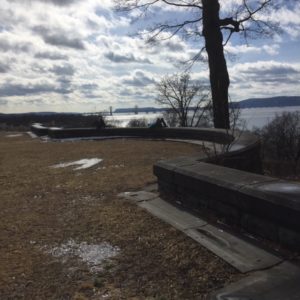
Thursday, a warm and sunny post-snowstorm day, while visiting my daughter and her family in Tarrytown, New York, I’d asked her if we could maybe take a walk along the Hudson. Her eyes lit up: “Oh, yes,” she said, clearly excited to share yet another feature of her still-newish community (She and her family had moved to Tarrytown about a year and a half ago), “we can definitely arrange that.”
Ever since the UN report re climate change and how little time we have left, I am devouring books like The Overstory and Braiding Sweetgrass. My prayer life has expanded to include prayers, gratitude for all living things—especially trees. As much as I can, given winter weather and my urban surroundings, I’m walking through this precious, natural world as if both loving all I see and already mourning its loss. So I was psyched!
Land along the Hudson being prime real estate, I’d imagined our riverside walk would be maybe a mile or so long, on a wood-chip path through some overgrown vegetation, and end at some high-end development. So was astonished to find myself on the sculpted grounds of the Rockwood Hall State Park, perched above the Hudson, with magnificent views and wonderful, paved paths to explore but also, the beautifully designed landscape of a Frederick Law Olmsted-designed park. (It was my daughter’s father who’d first taught me how to recognize Olmsted’s eye-catching tree placement. On the campus of Vassar College. “See how your attention moves from this tree to that one and then to over there?” he’d coached. Yes. I did. Still do.)
But, wait! What’s the story behind all this magnificence? Who’d preserved these eighty-eight acres? Who’d made possible all this room with a view? Who’d hired Olmsted? The answer is: William Rockefeller. The brother of John D. Rockefeller and co-owner of Standard Oil Company. (I can still remember how brilliant I’d considered myself at eight or ten when I’d figured out that Esso, as in the name of the gas station—now known as Exxon, of course—was actually S. O. As in Standard Oil.) He’d built Rockwood Hall; its foundations still stand although the mansion is gone. And, eventually, his vast estate—less than half of it anyway—became a state park.
Oh the irony. That our magnificent view, those perfectly-placed oaks and firs and sugar maples and sycamores, our excitement to watch soaring red-tailed hawks and a bald eagle, that glorious walk could have only happened because of the enormous wealth derived from a fossil fuel! A commodity which, like coal and natural gas, will make this planet unlivable for many, many species unless something truly miraculous happens.
Egad.
Egad.
Thanks for this background information about Rockwood Hall. I also just learned from Yoruba Richen’s documentary “Green Book” that Esso sold the Green Book guide at their gas stations, which was part of how and why it took off more than other Jim Crow era guide books for African-Americans.